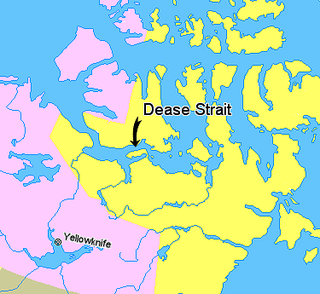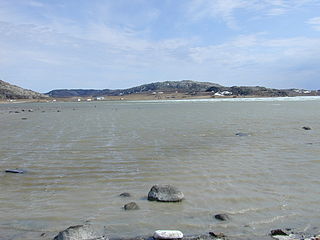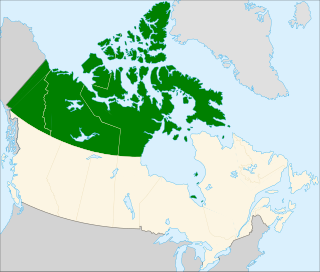Ogden Bay is an Arctic waterway in Kitikmeot Region, Nunavut, Canada. It is located in the southern Queen Maud Gulf off Nunavut's mainland. Chester Bay is situated 32 km (20 mi) to the west, Armark is to the east, and the Keith Islands are to the north.
The Rae River (Pallirk) is a waterway that flows from Akuliakattak Lake into Richardson Bay, Coronation Gulf. Its mouth is situated northwest of Kugluktuk, Nunavut. Its shores were the ancestral home of Copper Inuit subgroups: the Kanianermiut and the Pallirmiut.

The Kent Peninsula is a large peninsula, almost totally surrounded by water, in Nunavut's northern Canadian Arctic mainland. Were it not for a 5-mile isthmus at the southeast corner it would be a long island parallel to the coast. From the isthmus it extends 105 mi (169 km) westward into the Coronation Gulf. To the south, Melville Sound separates it from the mainland. To the north is Dease Strait and then Victoria Island. To the west is Coronation Gulf and to the east, Queen Maud Gulf. Cape Flinders marks the western tip of the peninsula, Cape Franklin is at the northwestern point, and Cape Alexander marks the northeastern point.
Akuliakattagmiut were a geographically defined Copper Inuit subgroup in the Canadian territory of Nunavut. They were located near Cape Bexley on the south shore, mainland side of Dolphin and Union Strait, and in the vicinity of the Melville Hills' Akuliakattak Lake, the source of the Rae River.
Haneragmiut were a geographically defined Copper Inuit subgroup in the Canadian territory of Nunavut. They were the most westerly band of those that hunted in southern Victoria Island. They were generally located on the north shore of Dolphin and Union Strait, north of Cape Bexley, and south of Prince Albert Sound, on Victoria Island. Though they migrated seasonally both north and south for hunting, fishing, and trade, they were unaware that Victoria Island was an island.
Kogluktogmiut were a geographically defined Copper Inuit subgroup in the Canadian territory of Nunavut. They were located by Bloody Falls, a waterfall on the lower course of the Coppermine River in the Kugluk/Bloody Falls Territorial Park, notable for the Bloody Falls Massacre.
Sutton Island is located in northern Canada's territory of Nunavut. It is situated in the Dolphin and Union Strait immediately next to Liston/Listen Island. Rymer Point and Simpson Bay, on Victoria Island's Wollaston Peninsula are to the northeast. Bernard Harbour, on the mainland, is to the southwest, as is Chantrey Island.
Cape Bexley is a headland in the northern Canadian territory of Nunavut. It is located on the mainland, on the south shore of Dolphin and Union Strait, and bounded on the south by Souths Bay.
The Haningayogmiut were a Copper Inuit subgroup located on the Back River (Haningayok). According to Arctic explorer Vilhjalmur Stefansson, the Haningayogmiut were a small tribe. The Kaernermiut were also located on the Back River and may have been the same subgroup.
Kaernermiut were a Copper Inuit subgroup. They were located on the Back River, and, they frequented the Thelon River. The Kaernermiut remained inland through all the seasons, coming to the sea only as single families visiting other tribes. For this reason, they did not kill seals, living instead on caribou and muskoxen. Their land was east and south of the Ahiagmiut. Because the Haningayogmiut were in the same general area, they may have been the same people, with a different name.
The Kangiryuarmiut were a Copper Inuit subgroup. They were located on Victoria Island in the areas of Prince Albert Sound, Cape Baring, and central Victoria island. They were also found around Nelson Head on Banks Island. Kangiryuarmiut subsisted on bear. They were the only Copper Inuit who built iglooit on land. The Kangiryuarmiut speak the Kangiryuarmiutun subdialect of Inuinnaqtun dialect of Inuvialuktun language.

The Umingmuktogmiut are a geographically defined Copper Inuit band in the northern Canadian territory of Nunavut, Kitikmeot Region. They were located on the western coast of Kent Peninsula, and also further south in eastern Bathurst Inlet around Everitt Point by the Barry Islands. Umingmuktogmiut were notable amongst other Copper Inuit as they had a permanent community, Umingmuktog. They could hunt and fish for Arctic char, Arctic fox, barren-ground caribou, fur seals, and muskox prevalent in the area.
The Kugaryuagmiut are a geographically defined Copper Inuit band in the northern Canadian territory of Nunavut, on the mainland, in Kitikmeot Region. According to Arctic explorer Vilhjalmur Stefansson's 1908-1912 ethnographic journals, they numbered about 25 at the time. In the summer, they hunted in the region of the Kugaryuak River, which flows into the Coronation Gulf, where they subsisted during the winter, the same as other Copper Inuit of that region.
The Pingangnaktok are a geographically defined Copper Inuit band in the northern Canadian territory of Nunavut, on the mainland, in Kitikmeot Region. According to Arctic explorer Vilhjalmur Stefansson's 1908-1912 ethnographic journals, they numbered about 30 at the time. In the summer, they hunted to the west of Tree River, which flows into the Coronation Gulf, where they hunted during the winter, the same as other Copper Inuit of that region.
Pallirmiut were a geographically defined Copper Inuit group in the Canadian Arctic territory of Nunavut. They were located by the mouth of the Rae River (Pallirk) during the spring. Some stayed there during summers, while others joined the Kogluktogmiut at the Bloody Falls summer salmon fishery. Pallirmiut wintered on west central Coronation Gulf, and went inland when the snow was gone, carrying packs rather than using sleds.
The Roscoe River is a waterway located above the Arctic Circle on the mainland of Northern Canada.
The Kilusiktogmiut were a Copper Inuit subgroup. They lived on Victoria Island, east of the Nagyuktogmiut who were known to inhabit the area northeast of Lady Franklin Point. They also lived on the mainland along the Coronation Gulf, particularly at the mouth of the Mackenzie River. They spent at least some time on the Banks Peninsula by Bathurst Inlet.





